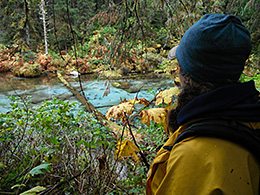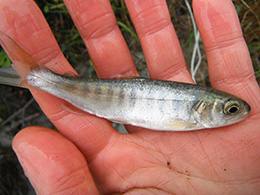Alaska Fish & Wildlife News
June 2013
Anticipating Field Season in Alaska
Confessions of a Salmon Ambassador

The familiar cocktail of anxious excitement and nervous reservation tap-dances through my gut. It’s the distraction that makes me stir my coffee long after the sugar has dissolved and the cream has blended; the quiet commotion that finds me staring through the maps on my computer screen; the long-awaited disturbance that hiccups the monotony of winter’s report writing. It is field season.
Summer people buzz about the seasonal jobs they have taken. Some folks will migrate south at the end of the tourist season; some, like myself, will find themselves here year-round, marveling at how quickly time flies. The decks of ferries lumbering up from Bellingham will soon be blooming with tents and resonating with twangy tunes sung by flanneled strangers who will become friends and lovers, united by the common Alaskan vision quest.
I find myself, 11 years after emerging like a rumpled caddis fly from my own ferry tent, kneeling on the thin carpet of my cubicle packing plastic totes with bug spray, GPS units, and Rite-In-The-Rain notebooks. I am preparing to return to the woods, eyes to the stream, ears to the forest. I have learned to look into the spaces between the trees, to listen for sounds beyond my own footsteps. My work takes me inside the lush, thorny embrace of southeast Alaska’s temperate rainforest, from the abundant wilds of Chilkoot Valley to Sitka’s rocky outer coast. My job is to map streams, dutifully following their every meander, through the river and over the woods, to the upper extent we go…searching for the last possible water that is home to the resource that makes Alaska’s heart beat like it means it.

I am searching for fish. The earliest, tiniest migrants wriggle from their gravel redds and are swept downstream, their greenish silver skins glinting like lost jewelry in the water. I dip my net in their path and scoop, the pouch of the mesh shivering with wide-eyed pink salmon. I don’t count them; I simply want to know they are there. I gently lower the net back into the water and the silver mass rinses away. Soon I will be capturing, recording, and releasing tiger-striped juvenile coho salmon whose habitats range from algae-encrusted roadside ditches to calm respites in raging rivers. I recall being draped over a log, immersing my camera in a still pool to photograph a school of coho fry. After a few bursts of the flash, the tiny fish began moving toward my hand, attracted by the light. The mellow curiosity of these infant animals is a far cry from the elusive fighters they become as adults.
After every sample, I bite the glove off my hand, press the waypoint into my GPS, and scribble details into my field-beaten notebook. Later I will purge my device of its numerical memories, play connect-the-dots with my mapping program, and remember the day we were “managed by alders” and rewarded ourselves with wild rhubarb pie ala mode.

The notebook will become a diary of captures, weather, and moods. There will be expletives and frustrations, joys and exclamations, not to mention the occasional bug carcass splayed across the pages. For all the technology I lug through the woods with me, all the batteries and electricity, this notebook is evidence of the beast and the beauty that is fieldwork. When emotion gives way to technical objectivism, I can return to these wrinkled, grimy pages and remember that there is a human softness behind the science.
This summer will find me on Mitkof Island with my wonderful crew, searching for fish, documenting streams, and likely having a laugh along the way.
Tess Quinn is a Fish and Wildlife field technician for the Habitat division, and documents anadromous fish streams to update the Anadromous Waters Catalog. As a salmon ambassador she does her best to represent anadromous fish and the upper extent of their habitats.
Subscribe to be notified about new issues
Receive a monthly notice about new issues and articles.
